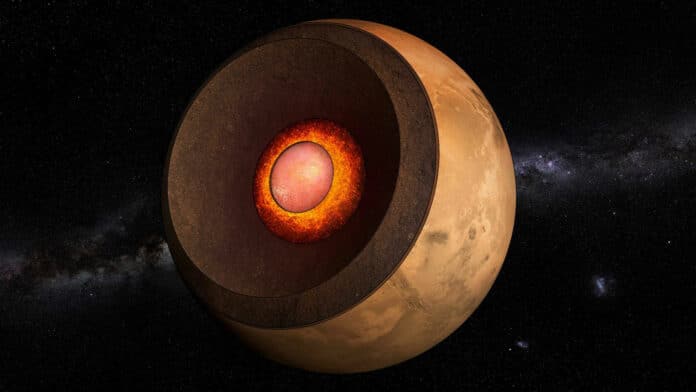Mars’s liquid core would need to be about 27% lighter than pure liquid iron, according to seismic recordings taken during the InSight mission. This suggests a significant supplement of lightweight components. However, compared to the cosmochemically available volatile elements found in the most likely constituents of Mars, core compositions based on seismic and bulk geophysical constraints call for higher concentrations of the components sulfur, carbon, and hydrogen.
Using its seismometer, NASA’s InSight lander monitored earthquakes on Mars for four years. To ascertain the interior structure of the planet, scientists at ETH Zurich gathered and examined the data sent to Earth. They found something exciting.
A new image of the planet’s innards is created by combining computer simulations with examining recorded earthquakes. A roughly 150-kilometer-thick layer of liquid silicate (magma) is situated between the solid silicate mantle and the liquid iron alloy core of Mars. This study also offers new information on the size and composition of Mars’ core, resolving a mystery that researchers have until now been unable to explain.
The average density of the Martian core had to be far lower than that of pure liquid iron, according to an examination of the first recorded earthquakes. For example, the iron content of the Earth’s core is around 90% by weight. Light elements like carbon, hydrogen, oxygen, and sulfur account for about 10% of the total weight. Early calculations of the Martian core’s density revealed that, at about 20% of its importance, a far higher proportion of light components make up the core.
Dongyang Huang, a postdoctoral researcher in the Department of Earth Sciences at ETH Zurich, said, “This represents a huge complement of light elements, bordering on the impossible. We have been wondering about this result ever since.”
According to the latest measurements, the Martian core’s radius has shrunk from the 1,800–1,850 km range that was first calculated to between 1,650 and 1,700 km, or around 50% of Mars’ total radius. It follows that the Martian core has a higher density and fewer light components if it is smaller than previously believed but has the same mass. The percentage of light elements decreased to between 9 and 14 percent by weight, based on the updated estimations.
Paolo Sossi, Assistant Professor in the Department of Earth Sciences at ETH Zurich and member of the National Centres of Competence in Research (NCCRs) PlanetS, said, “This means that the average density of the Martian core is still somewhat low, but no longer inexplicable in the context of typical planet formation scenarios. The presence of many light elements in the Martian core suggests that it originated very early, maybe when the Sun was still encircled by the nebula gas that provided the material for the Martian core to gather light elements from.”
The first estimates were based on earthquakes near the InSight lander. On the other hand, the seismometer recorded two earthquakes on the opposite side of Mars in August and September of 2021. A meteorite collision was the cause of one of them.
Seismic waves from these earthquakes traveled through the core. Scientists were able to illuminate the body as a result.
As opposed to this, the waves from the previous earthquakes were reflected at the core-mantle border, yielding no clues about the Red Planet’s deepest interior. These latest findings have allowed scientists to calculate the fluid core’s density and seismic wave speed down to a depth of roughly 1,000 kilometers.
To infer the composition of the material from such profiles, scientists computed the properties of a wide variety of alloys using quantum-mechanical calculations, which they carried out at the Swiss National Supercomputing Centre (CSCS) in Lugano, Switzerland.
An issue arose when scientists compared their measurements derived from the InSight seismic data with the computed profiles. It was discovered that no iron-light element alloy could match the data at the Martian core’s center and top simultaneously. For instance, the iron alloy would have needed to include a lot more carbon at the core-mantle barrier than it does inside the core.
Huang said, “It took us a while to realize that the region we had previously considered the outer liquid iron core wasn’t the core after all, but the deepest part of the mantle.”
Scientists also found that the density and seismic wave speed measured and computed in the outermost 150 kilometers of the core were consistent with those of liquid silicates – the same material, in solid form, of which the Martian mantle is composed.
More computer simulations and further investigation of past earthquakes validated this result. It is just unfortunate that the InSight lander was unable to deliver more information that would have illuminated the composition and structure of Mars’s interior due to dirty solar panels and the ensuing lack of electricity.
Journal References:
- Khan A, Huang D, Duran C, Sossi PA, Giardini D, Murakami M: Evidence for a liquid silicate layer atop the Martian core. Nature, 25 Oct 2023, DOI: 10.1038/s41586-023-06586-4
- Samuel H, Drilleau M, Rivoldini A, et al. Geophysical evidence for an enriched molten silicate layer above Mars’ core, Nature, 25 Oct 2023, DOI: 10.1038/s41586-023-06601-8
